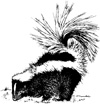Coloration - Teacher's Guide |
Episode Overview Junior Naturalist Patrice explains how coloration is a structural adaptation that helps animals and plants survive in their environment. She joins Senior Naturalist Dave Erler to examine the coloration of the great horned owl. We take an up-close look at the skunk. Von and Marrissa visit with wildlife photographer John Green and learn how color plays a role in photography. Junior Naturalist Patrice explains how coloration is a structural adaptation that helps animals and plants survive in their environment. She joins Senior Naturalist Dave Erler to examine the coloration of the great horned owl. We take an up-close look at the skunk. Von and Marrissa visit with wildlife photographer John Green and learn how color plays a role in photography.
Program ObjectivesStudents will: Vocabulary
Previewing Activities1. Have students name some animals and plants with unusual coloration and discuss how that coloration might help the them survive. 2. Have students name some ways color is used in human environments for warning, attracting and to camouflage or mimic. Post-Viewing Activities1. Have students make a list of animals that use: 2. Give students an outline of a butterfly. Explain that the classroom is the butterfly's habitat. Have them design an unique coloration pattern for their butterfly and write a brief paragraph explaining how the coloration of their butterfly helps it survive in the classroom environment. 3. Take a nature walk with your students and have them observe plants and animals and take notes about their coloration. Trials of the Toothpick BirdMaterials Neededcolored toothpicksgrassy area recording sheets ProcessTell the students that they are testing which color tooth-pick would survive the best in a grassy environment. The students are to play the part of the rare toothpick bird. Mark off a grassy area. Distribute an equal of each color toothpicks on the grass. Give the students 15 seconds to find as many of the toothpicks as they can. Record the number of toothpicks "eaten" for each color. Which color was the most vulnerable to the toothpick bird? Which one was the best protected? Note: You can do this activity as a whole class, or you can break the class into small groups. But We Can't Go Outside!If you can't go outside to do this activity, or if you don't have a grassy area, you can replicate the activity by distributing a sheets of newspaper to each student and sprinkling colored confetti and cut-up newspaper. Make sure there is an equal number of each! | Additional ResourcesWeb Sites Arkive Animal Dazzlers: The Role of Brilliant Colors in Nature by Sneed B. Collard Animals Brightly Colored by Phyllis Limbacher Tildes Bold and Bright, Black-and-White Animals by Dorothy Hinshaw Patent, illustrated by Kendahl Jubb How to Hide a Butterfly & Other Insects by Ruth Heller How to Hide a Crocodile & Other Reptiles by Ruth Heller How to Hide a Meadow Frog and Other Amphibians by Ruth Heller How to Hide a Parakeet & Other Birds by Ruth Heller How to Hide a Polar Bear & Other Mammals by Ruth Heller Nature's Paintbrush: The Patterns and Colors Around You by Susan Stockdale Searchin' Safari : Looking for Camouflaged Creatures by Marc Nadel, illustrated by Jeff O'Hare Darwinsim and Its Data: The Adaptive Coloration of Animals by Muriel L. Blaisdell |
